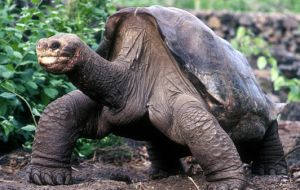MercoPress. South Atlantic News Agency
Lonesome George, last giant tortoise of its subspecies dies in Galapagos
 The giant tortoise and a great attraction of the park is believed to have been 100 years old
The giant tortoise and a great attraction of the park is believed to have been 100 years old Staff at the Galapagos National Park in Ecuador announced Lonesome George, a giant tortoise believed to be the last of its subspecies, has died. Scientists estimate he was about 100 years old.
Park officials said they would carry out a post-mortem to determine the cause of his death. With no offspring and no known individuals from his subspecies left, Lonesome George became known as the rarest creature in the world.
For decades, environmentalists unsuccessfully tried to get the Pinta Island tortoise to reproduce with females from a similar subspecies on the Galapagos Islands.
Park officials said the tortoise was found dead in his corral by his keeper of 40 years, Fausto Llerena.
While his exact age was not known, Lonesome George was estimated to be about 100, which made him a young adult as the subspecies can live up to an age of 200.
Lonesome George was first seen by a Hungarian scientist on the Galapagos island of Pinta in 1972. Environmentalists had believed his subspecies (Chelonoidis nigra abingdoni) had become extinct.
Lonesome George became part of the Galapagos National Park breeding program. After 15 years of living with a female tortoise from the nearby Wolf volcano, Lonesome George did mate, but the eggs were infertile.
He also shared his corral with female tortoises from Española Island, which are genetically closer to him than those from Wolf volcano, but Lonesome George failed to mate with them.
He became a symbol of the Galapagos Islands, which attract some 180,000 visitors a year.
Galapagos National Park officials said that with George's death, the Pinta tortoise subspecies has become extinct. They said his body would probably be embalmed to conserve him for future generations.
Tortoises were plentiful on the Galapagos Islands until the late 19th century, but were later hunted for their meat by sailors and fishermen to the point of extinction.
Their habitat furthermore suffered when goats were introduced from the mainland.
The differences in appearance between tortoises from different Galapagos islands were among the features which helped the British naturalist Charles Darwin formulate his theory of evolution.
Some 20.000 giant tortoises of other subspecies still live on the Galapagos.




Top Comments
Disclaimer & comment rules-

Read all commentsAfter failing to breed George just went into his shell (sorry !)
Jun 26th, 2012 - 02:26 pm 0Commenting for this story is now closed.
If you have a Facebook account, become a fan and comment on our Facebook Page!